How To Buy LED Tube Lights From China
By Johnny Updated: Jun 5, 2024
Many people want to buy LED tube lights from China, but they always worrying about things like language barriers,
complicated international trade process, scams, or bad quality products. In this guide, it’s easy for you to learn
all knowledge of the whole importing process from choosing profitable tube products to arrange shipment.
Table of Contents (13 aspects)
I. Introduction
II. Why Choose LED Tube Lights from China
III. Understanding Your Requirements
IV. Research and Due Diligence
V. Quality Assurance and Product Standards
VI. Navigating Language and Cultural Barriers
VII. Managing Shipping and Logistics
VIII. Payment and Payment Terms
IX. Intellectual Property and Legal Considerations
X. Taxes and Duties
XI. Successful Case Studies
XII. Conclusion
XIII. Additional Resources and References
I. Introduction
A. Brief overview of the Global LED tube light market
The global LED tube light market size reached US$ 3.8 Billion in 2022. Looking forward, IMARC Group expects
the market to reach US$ 7.5 Billion by 2028, exhibiting a growth rate (CAGR) of 10.6% during 2023-2028.
B. What is LED Tube Light (introduction)
LED tube lights are among the most popular and versatile lighting solutions available today. They are replacing
the fluorescent tubes widely with many advantages and benefits. You’ll often find LED tube lights being used to
provide bright, even lighting across many types of wider or open spaces, include supermarket, office, workshops,
laboratories, and car parks.
1: Sizes:
The most common LED tube light types include:
T8 LED tube (1 inch diameter)
T12 LED tube (1.5 inch diameter)
T5HO LED tube (5/8 inch diameter)
The number after the letter “T” indicates the diameter of the tube, in eighths of an inch. A T8 lamp, therefore,
has a diameter of 8 eighths of an inch (8/8 inch), or exactly 1 inch. Each of these LED tube light types can
be found in a variety of lengths, ranging from 1-ft (30 cm) to 8-ft (240 cm).
2:Advantages:
Compared to fluorescent tube lights, the most important advantages of LED tube lights are energy efficiency
and long life.
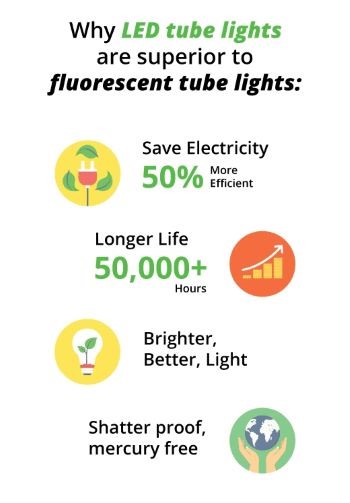
1): Energy Savings Up to 50%
Our Reapway 18W 130LM/W LED T8 VS Conventional Philips 1.2M 36W fluorescent T8
eg 1000pcs Reapway 18W LED T8 for a shopping mall project:
1: Save 92,000KWH electricity a year and 50% electricity
2: Save electricity cost 7,360$/year
3: Improve 3 times lifespan
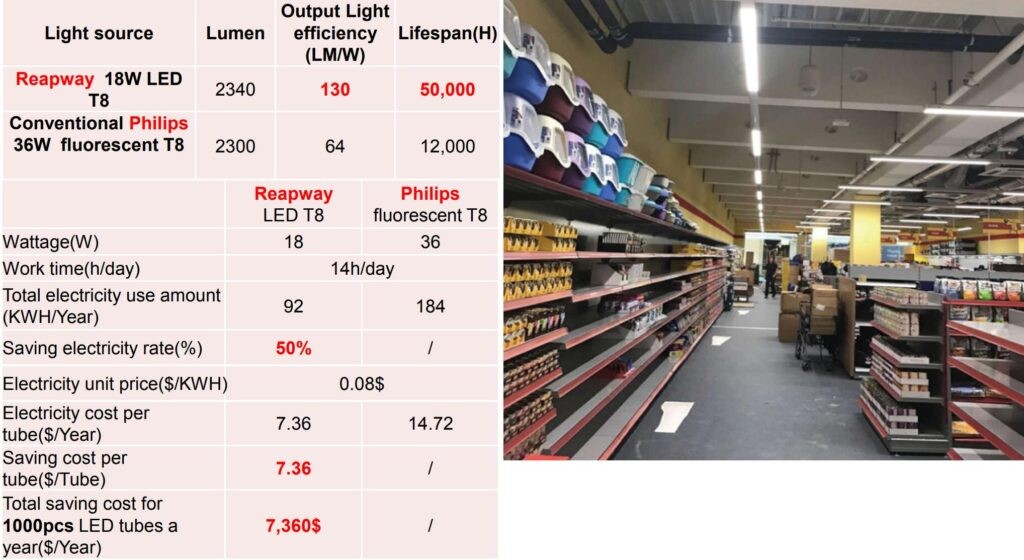
2): Much Longer life
The average life of a fluorescent tube is 5,000hs, while a LED tube will last 50,000hs and 10 times longer life
than fluorescent tube.

3): Higher Light Efficiency
LED tube light can cut costs down drastically with its efficiency. eg, our Reapway newest 18W LED T8 tube
outputs 3240lm and reach 180lm/w ! That is 100% higher than fluorescent tube that is only 90lm/w.
4): Higher Color Rendering (CRI)
CRI is very important because it directly affects how well people see and how they discern color.
The right LED tube lighting with higher CRI can help improve focus, productivity, and overall health and wellness.

5):Rigid and safe
LED tube light body is made by epoxy resin instead of glasses for the traditional fluorescent lamps.
So it is more rigid and safe.
6):Wider colour temperatures
LED tube light can be made with different colour temperatures as below:
3000K – warm white.
4000K – natural, good for office or other areas of work.
5000K – pure white, good for large spaces.
6000K – cool white.
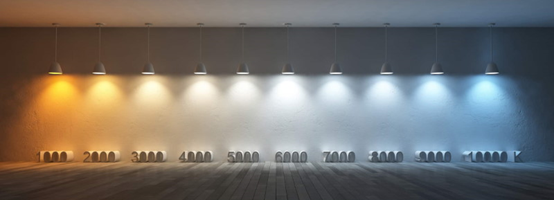
3: LED Tube Light Types
By working theory: Ballast Compatible and Ballast Bypass
Ballast Compatible: Very easy Plug-and-Play Installation, which work with the existing fluorescent fixture ballast in place.
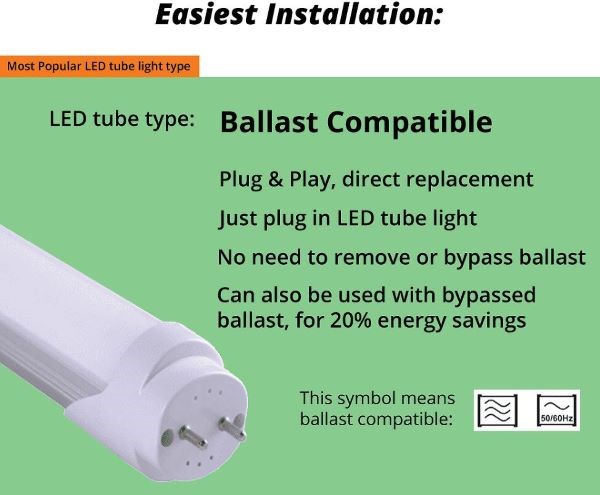
Ballast Bypass: Lower cost but requires bypassing / removing ballast from light fixture.
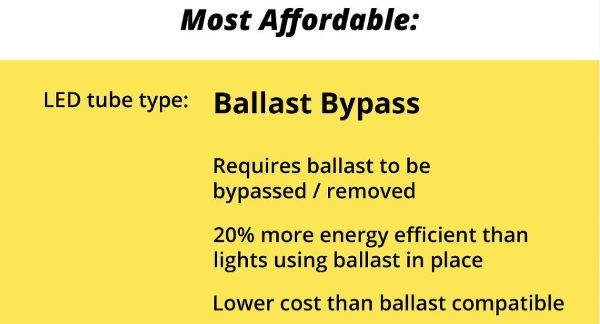
4: LED Tube Light Applications
Typical applications of LED tube lights include public premises, industrial production premises, warehouses,
parking garage and stores.
High bay fixture tube light
High bay fixture tube light is an outstanding solution for high mounting height industrial or retail applications.
The HB optic has been optimized to provide maximum performance from T8 LED tubes. Optional uplight
component is provided to enable excellent ceiling uniformity.
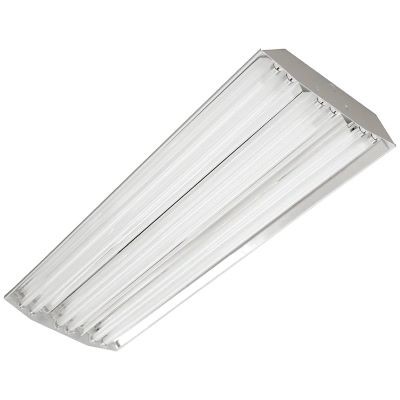
IP65 LED Batten tube waterproof light fixture
It is ideal for parking garages, industrial freezers, livestock and other harsh&wet environment lighting applications.
This vaportight high bay fixture was designed for demanding applications involving dust, dirt, vapor, smoke, high
levels of humidity, and risk of corrosion.
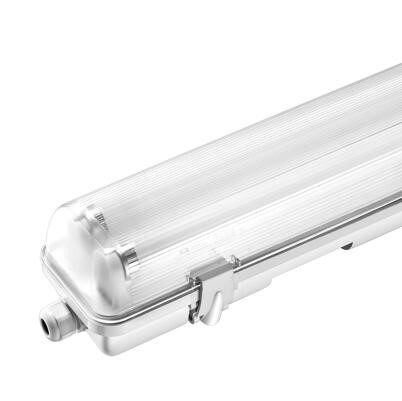
LED long tube light strip fixture
The LED long tube light surface mounted batten fixture in either single or twin tubes designed for ease
of installation and maintenance. The bare batten design provides maximum light output and well-suited
to supply general lighting to garages, warehouses, basements, and car parks.
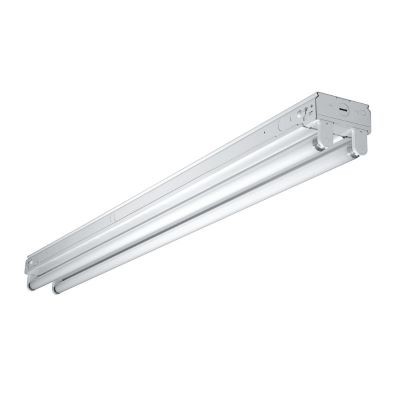
Recessed ceiling light fixtures
2’x2’ and 2’x4’ recessed grille lighting is the ideal solution for renovating existing fluorescent troffer
and parabolic systems delivering improved quality of light and refreshing the space. High efficacy light
engines deliver long life and excellent color, ensuring a superior quality lighting installation that is highly efficient
and sustainable.

II. Why Choose LED Tube Lights from China
A. The quality and technology of Chinese LED tube lights
B. Cost-effectiveness and competitive pricing
C. Vast product variety and customization options
There are three key factors that make choosing LED tube lights from China an attractive proposition:
quality and technology, cost-effectiveness, and the diverse range of products and customization options.
A. The Quality and Technology of Chinese LED Tube Lights
A study found that many Chinese LED tube lights adhere to rigorous international quality standards such as
CE, RoHS, and UL, ensuring they meet stringent performance and safety criteria.
Chinese LED tube lights often have longer lifespans and higher durability compared to traditional fluorescent tubes.
Chinese manufacturers have invested heavily in research and development, leading to the incorporation of advanced LED
technology, including smart lighting solutions, switchable color temperatures and power, and enhanced energy efficiency.
B. Cost-Effectiveness and Competitive Pricing
One of the most compelling reasons to source LED tube lights from China is the cost-effectiveness and competitive pricing.
China’s vast manufacturing capabilities and economies of scale enable manufacturers to produce LED tube lights at a lower
cost, making them an economical choice for customers.
C. Vast Product Variety and Customization Options
Chinese manufacturers provide various types of LED tube lights, including T5, T8, and T12 tubes, with a range of lengths
and wattages to suit different applications.
Customization options are widely available, allowing customers to select features such as color temperatures
(eg, warm white, cool white), beam angles, and even branding. Smart lighting solutions, including dimmable
LED tube lights and remote-controlled options, are readily available, catering to diverse lighting requirements.
III. Understanding Your Requirements
A. Identifying your lighting needs and specifications
B. Energy efficiency and certification requirements
C. Budget considerations
The critical first step encompasses identifying your lighting requirements and specifications, considering energy
efficiency and certification needs, and carefully assessing your budget. Let’s delve into each of these aspects to
ensure a successful purchase.
A. Identifying Your Lighting Needs and Specifications
Start by assessing the purpose of the lighting installation and the environment in which the lights will be used.
Are you lighting up a commercial workspace, a residential area, or an industrial facility? The answers to these
questions will help you determine factors such as:
Lumen Output: The required brightness or lumen output varies depending on the space and its purpose.
Different spaces will require varying levels of illumination.
Correlated Color Temperature (CCT): Consider whether you need warm white, cool white, or daylight LED
tube lights to create the desired ambiance.
Size and Shape: LED tube lights come in various sizes and shapes. Determine the specific dimensions and
form factors that suit your lighting fixtures.
Compatibility: Ensure that the LED tube lights you choose are compatible with your existing fixtures.
B. Energy Efficiency and Certification Requirements
In today’s world, energy efficiency is a top consideration. LED tube lights are known for their energy-saving
capabilities.
Consider Energy Efficiency: Check the energy efficiency rating of the LED tube lights. Higher efficiency means
lower energy consumption and reduced long-term operational costs.

Certifications: Look for lights that adhere to international standards and certifications, such as ENERGY STAR, CE,
and RoHS. Certifications indicate that the lights meet quality and safety requirements.
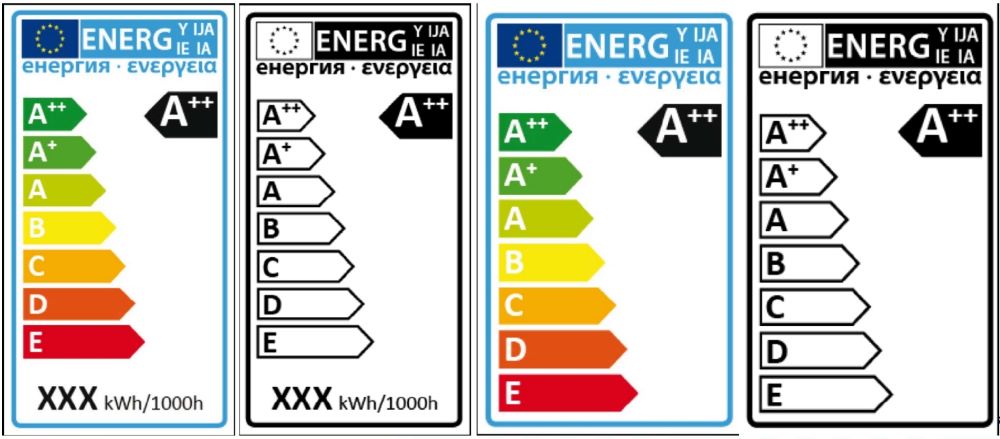
C. Budget Considerations
Your budget is a key factor in your purchasing decision. It’s essential to find a balance between meeting
your lighting needs and staying within your financial limits.
Establish a Budget: Determine a realistic budget for your LED tube light purchase. This will guide your choices
and help you narrow down options.
Consider Long-Term Savings: While energy-efficient LED lights may have a higher upfront cost, they often result
in long-term savings through reduced electricity bills and maintenance costs.
IV. Research and Due Diligence
A. Researching reliable suppliers
1. Online platforms (Alibaba, Made-in-China, etc.)
2. Search Chinese suppliers on Google
3. Trade shows and exhibitions
4.Find suppliers from LinkedIn or Facebook.
B. Verifying supplier credentials
1. Company background and history
2. Quality certifications and standards
3. Client testimonials and references
C. Communicating with potential suppliers
1. Inquiries and requests for quotations (RFQ)
2. Language and communication challenges
3. Negotiating terms and conditions
Sourcing LED tube lights from China can be a lucrative venture, but it’s imperative to undertake comprehensive
research and due diligence before engaging with potential suppliers.
A.Researching Reliable Suppliers
1: Online Platforms (Alibaba, Made-in-China, Global source, etc.)
eg Use Alibaba RFQ to Get Best-matched Suppliers
Alibaba RFQ (Request for Quotation) is a free service provided by Alibaba to global buyers to post buying requests
and manage all quotations on the RFQ service platform. Then you can review, compare and manage all the quotations.
Steps:
Step 1: Go to Alibaba RFQ main page.
Step 2: Complete the RFQ form as shown below.

Step 3: Submit RFQ by Clicking the Submit Button.
Step 4: Check Quotations in the Message Center of RFQ Dashboard.
Step 5: Select Suppliers for the Next Step.
After reviewing the quotes and supplier profiles, if you’re satisfied with 2-3 suppliers, you can talk with them directly
either for further price negotiation or to collect samples to check quality.
If unfortunately none of these prices are acceptable, as said earlier, you can either launch another RFQ or try sending
inquiries directly on Alibaba.
Step 6: Close an RFQ if You don’t Want to Get Any Quotes.
You can directly go to Alibaba “Message Center”, click the drop-down button, and switch to RFQ. Find the RFQ you
want to close and click “Close” to end it.
Flowchart for Using Ali RFQ to Find Suppliers
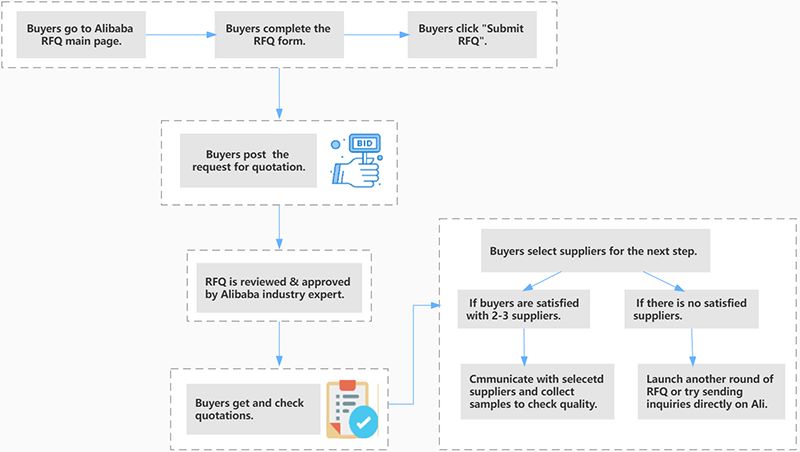
2. Search Chinese suppliers on Google
You can find Chinese suppliers on google by searching the product keywords like LED TUBE LIGHT CHINA
and combining my following suggested keywords. Then look at the Top 100 search results no matter it’s
organic search results or advertisement.
And pick out those websites examine supplier profiles, looking for vital information like product offerings,
certifications, and supplier ratings and customer reviews. These can provide insights into the supplier’s
performance and reliability.
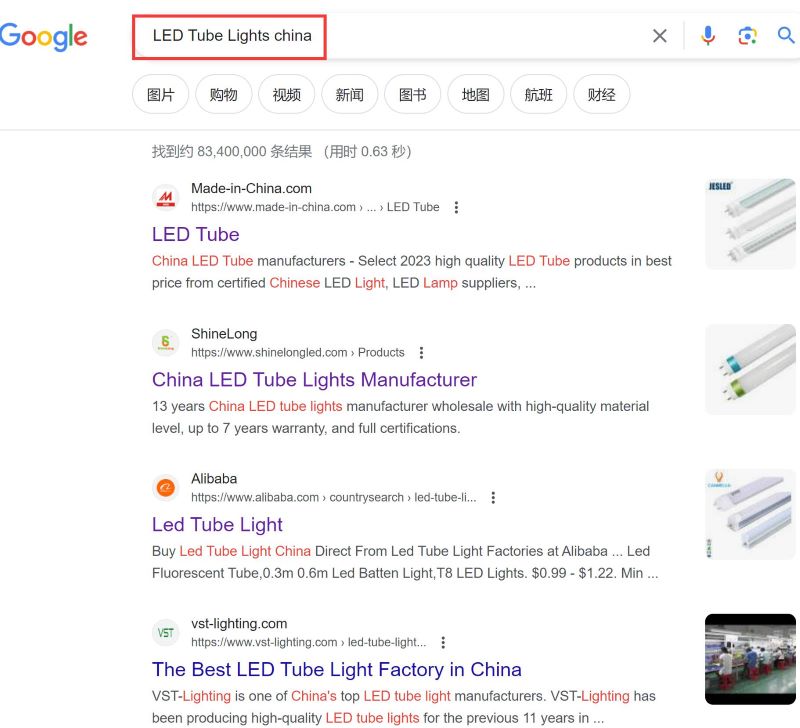
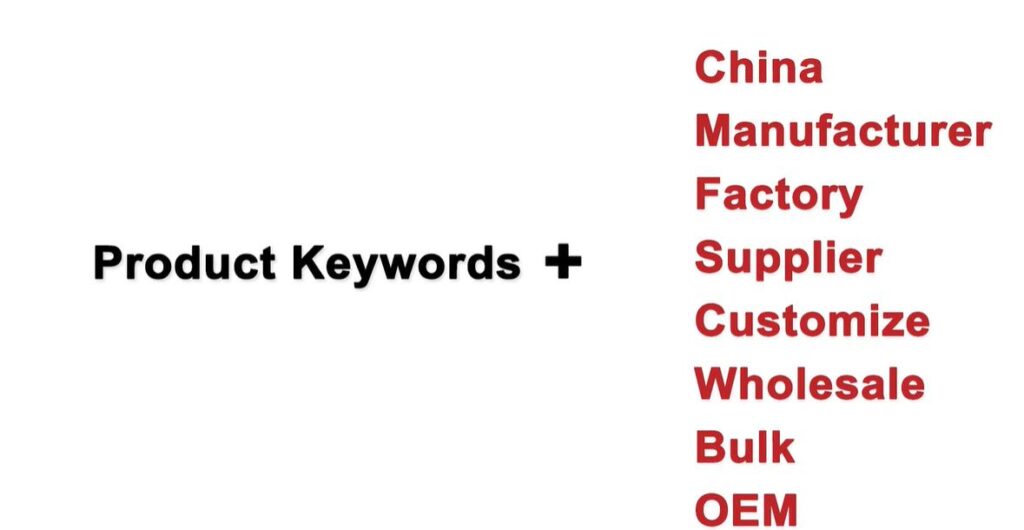
3.Trade Shows and Exhibitions:
Participating in trade shows and exhibitions is another effective way to identify potential suppliers.
Key considerations include:
Networking: Engage in meaningful conversations with suppliers at trade shows. Discuss your specific requirements and expectations.
Product Showcase: Evaluate the quality of LED tube lights on display and inquire about customization options.
Collecting Information: Gather supplier brochures, contact information, and any pertinent materials for later reference.
4. Find suppliers from LinkedIn or Facebook
LinkedIn and Facebook are the two most common places for Chinese supplier find customers because it’s free.
They usually search the keyword that has a relationship with the product or their industry to discover potential buyers.
And then try to get the attention of more potential customers by promoting their products, or posting their company’s
product information or publishing articles about their product.
So you can also use the same way to find the supplier on LinkedIn or Facebook. Just simply search the product keywords
and combine these business related keywords to discover if there is any Chinese suppliers are posting related information.
Let’s take the LED tube light as an example. You can search the keyword “LED tube light manufacture” on LinkedIn.
It’s very easy to find products and company info posted by suppliers.
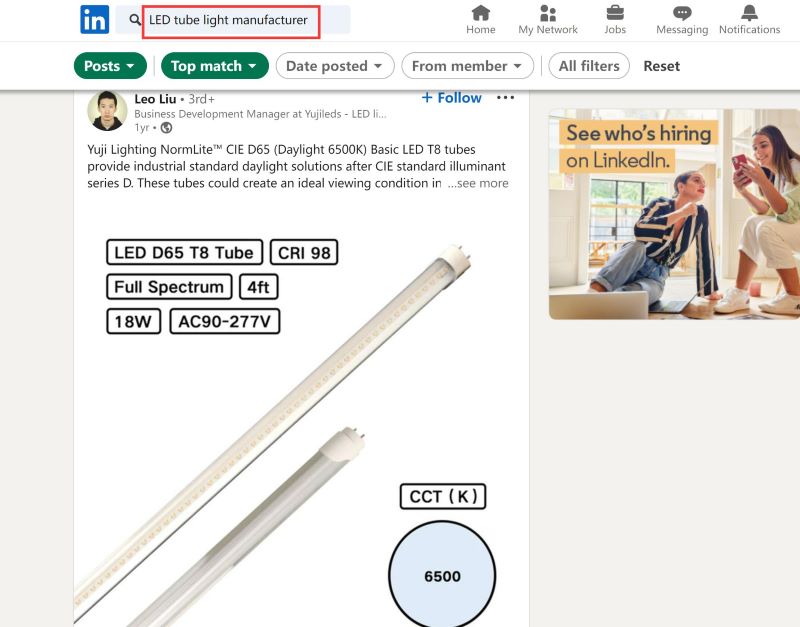
B. Verifying Supplier Credentials
Company Background and History:
Verifying the background and history of potential suppliers is crucial to ensure their legitimacy and reliability.
You can undertake this by:
Company Research: Investigate the supplier’s history, including the number of years in operation, key milestones,
and business growth. You can use the Whois to check when the supplier’s website domain is registered. The
longer the domain registered, and they are still doing the business, the less possible will be scammers.

Visit the Facility: If possible, consider visiting the supplier’s manufacturing facility in China to get a firsthand look
at their operations and assess their capabilities.
Quality Certifications and Standards:
Ensuring that your LED tube light supplier adheres to quality certifications and standards is essential for product
reliability. Look for the following:
Certification Verification: Confirm that the supplier holds relevant certifications such as ISO 9001, CE, and RoHS.
Ensure these certifications are current and valid.
Product Compliance: Verify that the LED tube lights meet your country’s safety and performance standards.
Client Testimonials and References:
Collecting client testimonials and references provides insights into the supplier’s track record and client satisfaction.
Key steps include:
Request References: Ask the supplier for references from previous clients who have procured LED tube lights.
Contacting References: Reach out to these references to gain firsthand information about their experiences
working with the supplier.
C. Communicating with Potential Suppliers
Inquiries and Requests for Quotations (RFQ):
Effectively communicating your requirements is crucial for a successful partnership. When making inquiries and requesting quotations:
Clear Specifications: Clearly define your needs, including quantities, specifications, and any customization requirements.
Timely Responses: Promptly respond to supplier inquiries and provide any additional information required.
Language and Communication Challenges:
Use of Interpreters: Employ interpreters if necessary to facilitate effective communication.
Email and Written Communication: When language barriers are significant, rely on written communication to ensure clarity.
Negotiating Terms and Conditions:
Negotiating terms and conditions with suppliers is a crucial step to establish a mutually beneficial partnership.
Key considerations include:
Pricing and Payment Terms: Discuss pricing, payment terms, and any bulk discounts that may apply.
Delivery and Lead Times: Clarify delivery times, shipping methods, and any logistical considerations.
Quality Control: Agree on quality control processes, inspection protocols, and dispute resolution mechanisms.
V: Quality Assurance and Product Standards
A. Compliance with international standards and regulations
B. The importance of sample orders
C. Inspection and quality control processes
When purchasing LED tube lights from China, ensuring product quality and adhering to international standards
is paramount. This chapter focuses on key considerations for quality assurance and product standards in your
LED tube light procurement journey.
A. Compliance with International Standards and Regulations
To ensure your LED tube lights meet international standards and regulations, several actions are necessary:
Certifications: Confirm that the products possess the required certifications, including CE, RoHS, and ENERGY STAR,
which indicate compliance with global safety and environmental standards.
Documentation: Request and review documentation related to product compliance with international standards,
as it may be a prerequisite for importation into your country.
B. The Importance of Sample Orders
Before making substantial commitments, it’s advisable to place sample orders to assess product quality
and supplier reliability. Sample orders help in:
Quality Evaluation: Examine the samples for factors like construction, materials, and light output. Ensure they
meet your specific requirements and expectations.
Supplier Evaluation: Assess how the supplier handles the order, including communication, packaging, and shipping.
This serves as a preliminary evaluation of their reliability.
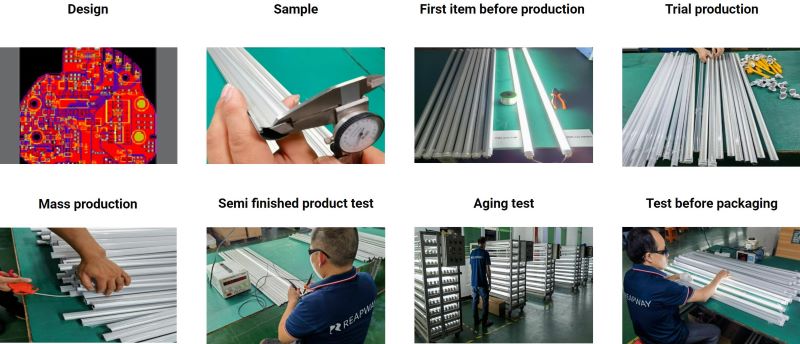
C. Inspection and Quality Control Processes
Implementing robust inspection and quality control processes is crucial to guarantee product quality and consistency.
Consider the following:
Third-Party Inspection: Engage third-party inspection agencies to evaluate LED tube lights for compliance with specifications, standards, and quality control.
Quality Control Protocols: Work with suppliers to establish quality control protocols, such as inspection checklists and testing procedures, to maintain consistent quality.
VI. Managing Shipping and Logistics
A. Choosing the right shipping method
B. Dealing with customs and import regulations
C. Freight forwarders and logistics partners
Once you’ve identified the right LED tube light suppliers and ensured product quality, the next critical step in the procurement process is managing shipping and logistics. This chapter will guide you through the essential considerations and strategies
for a smooth and successful shipping experience when buying LED tube lights from China.
A. Choosing the Right Shipping Method
Selecting the appropriate shipping method is crucial to ensure your LED tube lights arrive safely and on time. Consider the following factors when making your choice:
Shipping Modes: Evaluate options like air freight, sea freight, and express courier services(DHL,Fedex,UPS ect), and select the
mode that best aligns with your budget and delivery timeline.
Packaging and Labeling: Ensure that your LED tube lights are properly packaged and labeled according to shipping
regulations to prevent damage and delays.
B. Dealing with Customs and Import Regulations
Navigating customs and import regulations can be complex, but it’s essential for a hassle-free LED tube light procurement process. Key steps include:
Research Import Regulations: Familiarize yourself with your country’s import regulations, including tariffs and taxes that may
apply to LED lighting products.
Document Compliance: Ensure all required shipping and import documents, such as the commercial invoice and bill of lading,
are complete, accurate, and comply with local regulations.
C. Freight Forwarders and Logistics Partners
Freight forwarders and logistics partners play a crucial role in the efficient shipping of LED tube lights. Engage with them for the following benefits:
Expertise and Guidance: Rely on the expertise of freight forwarders to guide you through the intricacies of shipping and logistics, ensuring that your LED tube lights reach their destination smoothly.
Customs Clearance: Collaborate with logistics partners to facilitate customs clearance, manage documentation, and address any potential customs issues.

VII. Payment and Payment Terms
A. Safe payment methods for international transactions
B. Negotiating payment terms with suppliers
C. Avoiding common payment pitfalls
By selecting secure payment methods, skillfully negotiating payment terms, and staying vigilant against common payment pitfalls, you can enhance the safety and efficiency of your LED tube light procurement from China.
A. Safe Payment Methods for International Transactions
Choosing secure payment methods for international transactions is paramount to protect your investment and ensure a
smooth purchase process. Consider the following options:
Paypal (Suitable for Less Than $500 Payment ):
PayPal is the most convenient way on a payment arrangement. It accepts debit cards and credit cards, so it’s easy to send
money from any account of yours. And the process of sending money with PayPal is simple:
- Register a Paypal account using your email address.
- Connect your Bank Card with PayPal.
- Ask your recipient to do so if they don’t have a PayPal account too.
- When both of your accounts are ready, you can send money following the steps on PayPal.
PayPal Transfer Fee
There is a handling fee when you send money to China from your country, as it is a kind of international payment.
It depends on your payment methods, bank account, PayPay Cash balance, or cards.
The following transfer fee table of PayPal to China for reference (Based on the U.S. PayPal account sender):

(* Fee cost from PayPal.com)
Letter of Credit (L/C): This method guarantees payment to the supplier once specific conditions are met, safeguarding
both parties.
Bank Wire Transfers: A reliable method for transferring funds directly to the supplier’s bank account, but it’s essential
to exercise caution and ensure accurate recipient details.
Escrow Services: Platforms like Alibaba offer escrow services that hold funds until the buyer receives and approves
the LED tube lights.
B. Negotiating Payment Terms with Suppliers
Negotiating favorable payment terms is an essential part of procurement. Use these strategies to secure terms that
align with your financial interests:
Negotiate Down Payments: Discuss the possibility of a reasonable down payment with your supplier. A partial upfront
payment can demonstrate your commitment while retaining financial security.
Open Account Terms: Some suppliers may offer open account terms with established buyers, allowing for deferred
payment after LED tube lights are delivered and inspected.
C. Avoiding Common Payment Pitfalls
To safeguard your LED tube light procurement from common payment pitfalls, be vigilant in the following areas:
Counterfeit Payment Requests: Beware of fraudulent payment requests or altered bank details. Always verify payment
information with your supplier through secure communication channels.
Advance Payments to Unknown Suppliers: Avoid making substantial advance payments to new or unknown suppliers. It’s advisable to build a trusted relationship before doing so.
Underestimating Currency Exchange Risk: Consider currency exchange rate fluctuations and potential risks when making payments in a different currency.
VIII. Intellectual Property and Legal Considerations
A. Protecting your designs and intellectual property
B. Legal contracts and agreements
C. Resolving disputes and conflicts
Procuring LED tube lights from China involves not only navigating the market but also safeguarding your
designs and interests. This chapter delves into key intellectual property and legal considerations that will
protect your investments and ensure a seamless procurement process.
A. Protecting Your Designs and Intellectual Property
When buying LED tube lights, especially if you’ve developed unique designs or technologies, protecting your
intellectual property is paramount. Consider the following steps:
Patents and Trademarks: Seek patent protection for innovative designs and trademarks for your branding to
prevent unauthorized reproduction.
Non-Disclosure Agreements (NDAs): Implement NDAs with suppliers to maintain confidentiality, preventing the
sharing of proprietary information with third parties.
Intellectual Property Rights Registration: Ensure your designs and intellectual property are registered and
recognized in both your home country and China.
B. Legal Contracts and Agreements
Solidify your procurement process by establishing legal contracts and agreements that outline terms and responsibilities
clearly. Here are some critical considerations:
Purchase Contracts: Create comprehensive purchase contracts that detail product specifications, quality standards,
pricing, payment terms, and delivery schedules.
Quality Assurance Agreements: Establish quality assurance agreements that specify the inspection and testing
protocols, including any penalties or remedies for non-compliance.
C. Resolving Disputes and Conflicts
In the event of disputes or conflicts, having mechanisms in place for resolution is vital. Consider these steps:
Mediation and Arbitration: Include clauses in your contracts that allow for mediation or arbitration as an
alternative dispute resolution method, which can be more cost-effective and quicker than litigation.
Legal Counsel: Consult legal counsel experienced in international trade and dispute resolution in both your
home country and China.
Regulatory Agencies: Be aware of regulatory agencies and organizations that can assist in resolving
disputes in international trade, such as the International Trade Administration (ITA) or WTO.
IX. Taxes and Duties
A. Import taxes and duties in your country
B. Understanding VAT and GST
C. Strategies to minimize tax liabilities
Taxes and duties are integral to the importation process when buying LED tube lights from China. Understanding
these financial aspects is crucial to ensuring a successful and cost-effective procurement process. This chapter
explores import taxes, VAT/GST, and strategies to minimize tax liabilities.
A. Import Taxes and Duties in Your Country
Before purchasing LED tube lights from China, it’s essential to comprehend the import taxes and duties applicable in
your country. Key steps to consider include:
Research Tax Rates: Investigate the specific import tax rates and duties imposed on LED lighting products in your country.
Harmonized System Codes: Determine the correct Harmonized System (HS) code for LED tube lights to facilitate accurate
customs clearance and tax calculation.
B. Understanding VAT and GST
VAT (Value Added Tax) and GST (Goods and Services Tax) are common consumption taxes that can significantly impact
the cost of imported LED tube lights. Ensure you have a clear understanding of these taxes:
VAT or GST Rates: Learn the VAT or GST rates applicable to LED lighting products in your country.
Input Tax Credit: Explore whether you are eligible for input tax credits, which allow you to offset the taxes paid during import against taxes collected when you sell the products.
C. Strategies to Minimize Tax Liabilities
Minimizing tax liabilities is a key aspect of cost-effective procurement. Employ the following strategies to manage taxes
and duties more efficiently:
Utilize Trade Agreements: Leverage trade agreements and preferential trade programs that may reduce or eliminate
certain taxes on imported products.
Consider Customs Valuation: Evaluate the customs valuation methods and identify opportunities to minimize customs
values, where applicable.
Optimize Shipping and Logistics: Choose shipping methods and routes that help reduce tax liabilities, such as transshipment points with favorable tax treatment.
X. Case Studies and Success Stories
A. Real-world examples of businesses successfully sourcing LED tube lights from China
B. Lessons learned from their experiences
The best way to learn about procuring LED tube lights from China is through real-world examples. In this chapter,
we’ll explore case studies and success stories that shed light on the experiences of businesses that have successfully
sourced LED tube lights from China. We’ll also extract valuable lessons from their journeys.
A.Real-World Examples of Businesses Successfully Sourcing LED Tube Lights from China
Case Study : LED Linear™ – A Decade of Illuminating Success
In 2013, the German company “LED Linear” embarked on a journey by searching for Chinese suppliers through Google.
Fast forward a decade, thanks to the persistent pursuit of good product quality and good cooperation with suppliers,
and LED Linear™ stands as a global professional LED lighting leader. With 155 employees scattered worldwide, an
extensive network of partners and distributors, and branches spanning the USA, Singapore, France, and the Middle East.
The brands under its umbrella, such as LED Linear™, LEDsClick™, and TjAway™, have earned international recognition.
B. Lessons learned from their experiences:
1.Thorough Supplier Selection: Extensive research and supplier due diligence are critical to identifying reliable partners.
2.Strategic Communication:Effective communication, including clear
specifications and expectations, played a pivotal role in the success of these businesses.
3.Quality Assurance: Ensuring product quality through inspections, certifications, and adherence
to international standards is a non-negotiable factor.
XI. Conclusion
A. Summarize key takeaways
B. Encourage readers to explore the opportunities of sourcing LED tube lights from China
C. Offer a final word of advice
Conclusion: Navigating the Path to Brighter Illumination
In your quest to source LED tube lights from China, you’ve embarked on a journey filled with opportunities and
challenges. Let’s recap the key takeaways to guide you on this path:
A. Summarize Key Takeaways
Quality Assurance: Prioritize product quality and adhere to international standards.
Supplier Selection: Conduct thorough research and due diligence when choosing suppliers.
Communication: Effective and transparent communication is the bedrock of success.
Legal Considerations: Protect your intellectual property and understand the legal landscape.
Relationship Building: Foster long-term relationships with trusted suppliers.
B. Encourage Readers to Explore Opportunities
Sourcing LED tube lights from China offers endless opportunities for cost-effective, energy-efficient, and quality
lighting solutions. Embrace the chance to brighten your space while making a sound investment.
C. Offer a Final Word of Advice
As you embark on this procurement journey, remember that each step is an opportunity for growth and learning.
Approach challenges with determination, and never underestimate the power of due diligence. With careful planning,
open communication, and a focus on quality, your path to illuminating success becomes ever brighter.
XII. Additional Resources and References
A. Provide links to helpful tools, websites, and resources
B. List references and sources for further reading
A. Helpful Tools, Websites, and Resources:
https://who.is/: A Whois domain lookup allows you to trace the ownership and tenure of a domain name.
B. References and Sources for Further Reading:
United Nations Conference on Trade and Development (UNCTAD). (2021). Trade and Development Report 2021. UNCTAD.
World Intellectual Property Organization (WIPO). (2021). WIPO Intellectual Property Handbook: Policy, Law, and Use.


